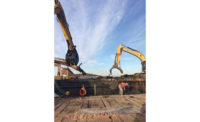Public-Works Professionals Launch New Education Center
The launch of a new career mentoring program for public-works professionals was the headline event at the annual American Public Works Association convention, which was held in Denver on Sept. 18-21 and attended by more than 6,000 APWA members.
The association has created the Donald C. Stone Center, named for the federal planner who founded APWA in 1937. It supports career education and organizes the association’s 96 newly inaugurated Fellows to mentor industry professionals.
“We inducted our first-ever group of industry Fellows at the convention, and they will be linked as mentors for a full year to people entering the careers program,” says APWA Executive Director Peter King. “All of the Fellows have 20-plus years of experience in public works, and we’re asking that they give at least a half-hour a week to advise people who want to enhance their careers.”
King says the new program builds on the chapter leadership institutes to offer a flexible, integrated approach to teaching leadership skills and presenting career options for technical or financial specialists who want to move into a management track. “We have an aging population in this industry, and we needed a more organized national program to bring new people along,” he says.
But foremost on the minds of many convention attendees is the ongoing issue of tight funding for public-works projects. The convention theme of “Innovation, Motivation and Elevation” was carefully chosen, says 2011 APWA President Diane Linderman, director of urban infrastructure and development services at Vanasse Hangen Brustlin Inc., Richmond, Va., because innovation has been the key to survival for many public-works directors. “Our people have become very good at innovating through times of difficult funding,” she says. “Now, sustainability has become the key to justifying the long-term value of projects and convincing taxpayers that their money isn’t just being spent for tomorrow.”
“It’s more a question of practicing asset management,” King adds. “Public-works officials need to take a more holistic approach to seeing their projects as just one part of creating healthy communities. If we can get an early presence at the planning table, we can cut costs and be creative in educating the public about the critical importance of keeping public infrastructure in good condition. That’s one of the key messages we’re trying to convey during this convention.”




